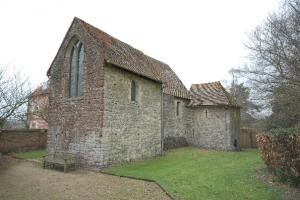 Built in 1290, on land granted to the Colepeper family by the Archbishop of Canterbury, Old Soar Manor would have dominated the medieval landscape. Designed to impress and entertain visitors as well as repel attack, the fortified manor provided an important gathering point for the local community. The closest major settlement was at Wrotham, which would have been several journeying hours away, so it was up to the Colepeper family to hold court in a manorial fashion. As such, Old Soar Manor was designed and furnished to display the family’s wealth and position in society. But this also made it a target for roaming thieves and the family incorporated the most up to date defences into its design.
Built in 1290, on land granted to the Colepeper family by the Archbishop of Canterbury, Old Soar Manor would have dominated the medieval landscape. Designed to impress and entertain visitors as well as repel attack, the fortified manor provided an important gathering point for the local community. The closest major settlement was at Wrotham, which would have been several journeying hours away, so it was up to the Colepeper family to hold court in a manorial fashion. As such, Old Soar Manor was designed and furnished to display the family’s wealth and position in society. But this also made it a target for roaming thieves and the family incorporated the most up to date defences into its design.
The manor’s grey ragstone walls are imposing, as are the cross loops through which 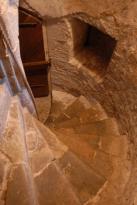 arrows could fly, but the only defence the family would have had from a serious attack were their servants, the two heavy wooden doors of the Undercroft and a steep, clockwise spiralling staircase. The stairs enabled a retreating defender to keep his sword arm free whilst a special recess at the top allowed the innermost door to close behind him, assuming he made it that far.
arrows could fly, but the only defence the family would have had from a serious attack were their servants, the two heavy wooden doors of the Undercroft and a steep, clockwise spiralling staircase. The stairs enabled a retreating defender to keep his sword arm free whilst a special recess at the top allowed the innermost door to close behind him, assuming he made it that far.
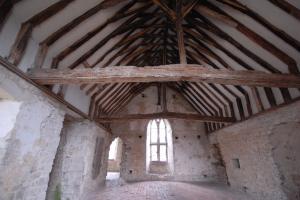 A large team of stonemasons were employed in the building of the manor and one of the dwelling’s most intriguing features are its putlogs, the evenly spaced square holes that can be seen both inside the great chamber and on the exterior walls. These holes once held the temporary wooden scaffolding erected during the building process and are now partially blocked to prevent birds from nesting.
A large team of stonemasons were employed in the building of the manor and one of the dwelling’s most intriguing features are its putlogs, the evenly spaced square holes that can be seen both inside the great chamber and on the exterior walls. These holes once held the temporary wooden scaffolding erected during the building process and are now partially blocked to prevent birds from nesting.
It is not known who actually designed Old Soar Manor, but around 1327 it was owned by 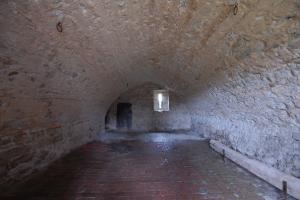 Captain Walter Colepepper, a man in his late twenties who was executed for treason against King Edward II. With his family taking the Earl of Leicester’s side during a rebellion against the King, Captain Walter refused to admit Queen Isabel entry to Leeds Castle. It was an event that was reported as follows: ‘Walter “sticked not to tell him” (the Queen’s Marshal) that neither the Queen nor any other should be lodged there without the commandement of his Lorde the owner.’ On the Queen coming to the gate in person ‘the Captaine most malapertly repulsed her, insomuch that she complained grievously to the King’ who besieged the place and eventually took it. ‘Then tooke he Captaine Colepeper and hoong him up.’ *
Captain Walter Colepepper, a man in his late twenties who was executed for treason against King Edward II. With his family taking the Earl of Leicester’s side during a rebellion against the King, Captain Walter refused to admit Queen Isabel entry to Leeds Castle. It was an event that was reported as follows: ‘Walter “sticked not to tell him” (the Queen’s Marshal) that neither the Queen nor any other should be lodged there without the commandement of his Lorde the owner.’ On the Queen coming to the gate in person ‘the Captaine most malapertly repulsed her, insomuch that she complained grievously to the King’ who besieged the place and eventually took it. ‘Then tooke he Captaine Colepeper and hoong him up.’ *
It was a fate he shared with his father, Sir Thomas Colepeper, who had been hung, drawn 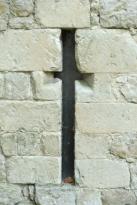 and quartered at Winchelsea following an earlier uprising in 1321. His two younger brothers, John and Nicholas, were also implicated in the rebellion and imprisoned at York Castle but were later released.
and quartered at Winchelsea following an earlier uprising in 1321. His two younger brothers, John and Nicholas, were also implicated in the rebellion and imprisoned at York Castle but were later released.
Surprisingly the manor managed to remain in the family for over 300 years, being used for 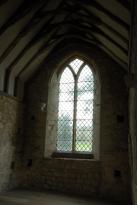 a variety of purposes as fashions and fortunes changed until it was sold to Nicholas Miller, a member of another wealthy local family, for £2,000 in 1601.
a variety of purposes as fashions and fortunes changed until it was sold to Nicholas Miller, a member of another wealthy local family, for £2,000 in 1601.
The Great Hall was demolished in 1780 and replaced with the Georgian red-bricked house that you can see today whilst the remaining sections of this once magnificent knights’ dwelling were used as a granary. In 1947 the building was given to the National Trust by Mrs S.L Cannon and restored to its present condition in 1949 by the Ministry of Works.
Now the building lies empty, its only occupants being small creatures of the countryside and passing visitors who come to seek out its history. Unless you believe in local folklore that is…
 ‘Jenny’ a local dairymaid, is believed to be the manor’s resident ghost. In the 18th Century, when the Geary family owned the manor, ‘Jenny’ was seduced by a drunken priest whilst helping out in the kitchens one Christmas. On finding herself with child, she went to the Chapel of Old Soar Manor to ask for aid. The priest fled the scene and Jenny, apparently weak from hunger and stress, sought refreshment from the water held in the piscina where the priest usually washed his hands. Sadly, legend has it that she fainted, hit her head and drowned in the two inches of ‘holy water’. How possible that actually is, is another matter but it was assumed that she had committed suicide and she was subsequently buried in unconsecrated ground.
‘Jenny’ a local dairymaid, is believed to be the manor’s resident ghost. In the 18th Century, when the Geary family owned the manor, ‘Jenny’ was seduced by a drunken priest whilst helping out in the kitchens one Christmas. On finding herself with child, she went to the Chapel of Old Soar Manor to ask for aid. The priest fled the scene and Jenny, apparently weak from hunger and stress, sought refreshment from the water held in the piscina where the priest usually washed his hands. Sadly, legend has it that she fainted, hit her head and drowned in the two inches of ‘holy water’. How possible that actually is, is another matter but it was assumed that she had committed suicide and she was subsequently buried in unconsecrated ground.
The whereabouts of her actual grave remain a mystery but some visitors to the Chapel have reported feeling a strange drop in temperature, a ghostly presence or music. Whilst others believe they have heard her footsteps pacing the Chapel floor.
Lynne Antwis, the House Steward, says she’s been coming to Old Soar Manor for years and hasn’t seen anything but who knows, you may strike lucky.
Now it’s your turn, do you have a favourite building or ghostly tale you would like to share? Please leave a comment and let me know!
And if you would like the latest snippets from the magpies nest delivered straight to you, please don’t forget to subscribe.
Coming soon – the missing mansion at Toys Hill.
Property Details
Old Soar Manor is jointly cared for by the National Trust and English Heritage. Admission is free and you can find out full visitor information here. Please note that there are no toilet facilities on site and limited parking is available on the roadside.
Acknowledgements
Eds note – this blog was initially posted on my Kent Life magazine blog in 2011 and has been used here as a sample of things to come.
I would like to thank Katherine Oatley, Visitor Service Manager, and Lynn Antwis, House Steward, both of the National Trust, for taking the time to talk to me, allowing me to tag along with the housekeeping team and for granting permission to take and display images.
I would also like to thank Warren Culpepper for supplying research links relating to the Culpepper family and Walter in particular. As a very distant relative, Warren has spent considerable time researching his family history and together with Lew Griffin, another family researcher, he runs the Culpepper Connections! website. Between them over 14,000 descendants have been found and should you be interested in finding out more about this fascinating family then this indexed site is a valuable resource. http://gen.culpepper.com/default.asp
Finally, I would like to thank Amanda Bryant for accompanying me on my trip and for taking the images shown.